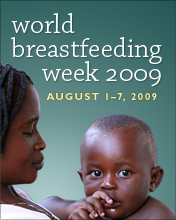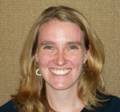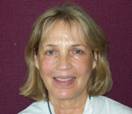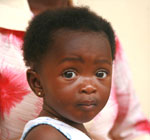 In an interview with CARE’s Abigail Beeson, a technical coordinator, and Mary Lung’aho, a special advisor, the two provide some insights into the programmatic challenges and lessons learned from their time spent working to integrate breastfeeding support skills and promotion capacity into CARE’s emergency program in Dadaab, Kenya.
In an interview with CARE’s Abigail Beeson, a technical coordinator, and Mary Lung’aho, a special advisor, the two provide some insights into the programmatic challenges and lessons learned from their time spent working to integrate breastfeeding support skills and promotion capacity into CARE’s emergency program in Dadaab, Kenya.
Q: What attracts you to working on nutrition programming in emergency settings?
 AB: The same thing that attracts me to nutrition in general. If you cannot support an environment where a child has the best start in life, how will we ever have an impact on infectious disease, education, and economics?
AB: The same thing that attracts me to nutrition in general. If you cannot support an environment where a child has the best start in life, how will we ever have an impact on infectious disease, education, and economics?
Q: Tell me a little about the program you worked on.
 ML: Since 2004, CARE USA has implemented an initiative to increase capacity to improve infant and young child feeding in emergency settings. CARE’s program sites include three refugee camps outside the town of Dadaab in northeastern Kenya. The camps, established in mid-1992, are home to refugee communities from throughout the region (e.g., Ethiopia, Burundi, the Democratic Republic of Congo, and Sudan), with Somalis making up the great majority of the population. Due to ongoing insecurity in Somalia, regular influx into the camps has continued throughout the period of the CARE initiative, with the population increasing at an average rate of 5,000 per month during 2008. The camp population, which was approximately 134,000 in 2005, now stands at approximately 240,000. Many of the new arrivals are pregnant and lactating mothers and children.
ML: Since 2004, CARE USA has implemented an initiative to increase capacity to improve infant and young child feeding in emergency settings. CARE’s program sites include three refugee camps outside the town of Dadaab in northeastern Kenya. The camps, established in mid-1992, are home to refugee communities from throughout the region (e.g., Ethiopia, Burundi, the Democratic Republic of Congo, and Sudan), with Somalis making up the great majority of the population. Due to ongoing insecurity in Somalia, regular influx into the camps has continued throughout the period of the CARE initiative, with the population increasing at an average rate of 5,000 per month during 2008. The camp population, which was approximately 134,000 in 2005, now stands at approximately 240,000. Many of the new arrivals are pregnant and lactating mothers and children.
From 2005 through the present, CARE, the United Nations High Commissioner for Refugees, GTZ (German Agency for Technical Cooperation), the International Rescue Committee, the National Council of Churches of Kenya, and other partners have worked in an interagency collaboration, the Dadaab Infant and Young Child Feeding Team, to provide support for infant and young child feeding in the camps. The objective is to integrate infant and young child feeding into ongoing, multisectoral programming rather than create a stand-alone system. Activities include orientation for all staff to ensure their understanding of their responsibilities in supporting appropriate infant and young child feeding practices, including emergency preparedness; ongoing training; training of facility and community-based counselors and mother-to-mother support group leaders/facilitators and provision of ongoing support through mentoring activities; implementation of behavior change communications approaches, which include the camp-wide annual celebration of World Breastfeeding Week; tracking program coverage and monitoring program process and results; and advocacy and feedback to the community on progress in improving infant and young child feeding practices and child nutritional status.
AB: In addition to providing program support to the infant feeding in emergencies initiative as outlined above, I did a qualitative study that looked at the breastfeeding practices of Somali breastfeeding women in all three of the Dadaab refugee camps in 2006. Focus group discussions and key informant interviews were held with mothers, pregnant and lactating women, men, youth (over the age of 18), grandmothers, traditional birth attendants, and community health workers to better understand breastfeeding practices, in particular initiation, and to compare them to previous practices from Somalia in order to understand if coping mechanisms had at all impacted a mother’s perceptions of her ability and desire to breastfeed in the refugee camps in Dadaab.
Q: What was your role?
ML: I assisted with program planning, training, development and review of technical materials, coaching and support of staff, and support for improved tracking of process and results.
AB: From a program perspective I was responsible for grants management, reviewing and editing technical materials, and supporting other program requests. As for the research, I headed the study with support from the CARE Kenya staff and refugee assistants.
Q: Tell me a time when you discovered that the programming in Dadaab was having a positive impact.
ML: I’m really impressed at the rate that the mother-to-mother support groups have spread. As of the last quarterly report there were 679 active groups. These aren’t groups that belong to the agencies either—they are groups women in Dadaab started themselves. I think that is why they are so popular. The women themselves really have taken ownership of the groups.
AB: While doing my research, I got to know some of the women in one of the camps. It was interesting to observe breastfeeding practices in that area, as without prompting or recognition, women on their own began to exclusively breastfeed and provide support to one another. During a visit to a household, I observed a woman asking another woman questions, and observing her as she breastfed, about positioning and about how the woman breastfeeding handled work and breastfeeding. Anecdotally, it seemed to be the best mechanism for the Somalis in the refugee camps, as emotions often ran high and there were incidences of people being stoned by other refugees who had been identified by the NGOs as being model individuals. It gave reassurance to me that, without coaxing, communities on their own initiative can change if they feel the desired behavior does have positive impacts.
Q: What were some of the challenges and lessons you learned from working on that program?
ML: There are many challenges to working in a setting such as Dadaab. One in particular was working with emergency-assisting staff who come from different backgrounds and cultures and who speak multiple languages (which also differ from those spoken by the emergency-affected population). This poses huge challenges, especially when training and adapting materials and implementing activities. Additionally, there is frequent staff turnover, which is a feature of many “difficult” situations. And of course working in coordination with multiple sectors and agencies to provide an integrated response is always challenging. Nevertheless, we developed pictorial training materials for lower-literacy staff and carried out ongoing orientation and capacity-building trainings in order to keep all the staff up to date and in the loop.
AB: The language barriers and literacy levels, as indicated by Mary, have been major challenges. During my research it was a challenge and it has been a challenge with our projects, as indicated. Measures are in place through the education system in the refugee camps and the hiring of recent graduates to try to rectify the problem, but identifying people who can translate with the appropriate technical background still remains an issue. It is not uncommon in situations such as this one, and I do think attempts are being made to try to address the issue, but given the nature of emergencies, it will likely be something that remains without a solution for some time.
Q: Do you have any advice for others working on nutrition programs in emergency settings?
ML: Don’t forget to bring a flashlight!
AB: Have patience, flexibility, and do not forget to have fun!
Visit CARE’s wiki pages—a space where anybody interested in health and development programming can connect with others, share key resources, and contribute.
About CARE’s Window of Opportunity Program
In recent years, the international community has recognized the undeniable window of opportunity that exists for improving nutrition, spanning from before pregnancy through the first two years of life—the crucial period for physical and mental development and human capital growth. Using an integrated forward-looking approach, CARE focuses its direct nutrition activities on this period of the life cycle, utilizing proven, cost-effective interventions that reduce stunting, wasting, micronutrient deficiencies, and ultimately maternal and child deaths. The Window of Opportunity Program works to improve the enabling environment, strengthen health system support, and empower communities and individuals to make optimal infant and young child feeding and maternal nutrition choices. The program’s work targets seven countries—Bangladesh, Indonesia, Kenya, Nicaragua, Niger, Peru, and Sierra Leone—and stems from a previous IYCF initiative, focused on emergencies. This program increased optimal feeding practices among mothers in Kenya, Indonesia, and the Democratic Republic of Congo. For more information on the Window of Opportunity Program, contact Lenette Golding at lgolding@care.org.
Visit the CARE Window of Opportunity wiki page.
Date: Aug 9, 2009 | Category: Q&As
